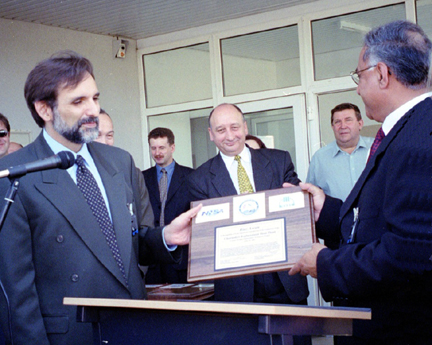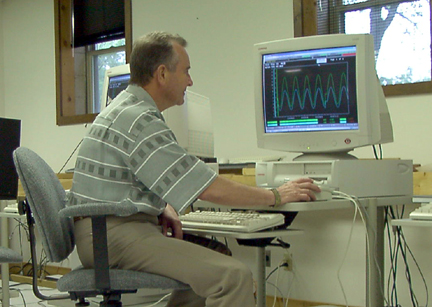
| April - June 2001 Contents Highlight |
Armenia Bulgaria Czech Republic Hungary |
Kazakhstan Lithuania Russia Slovakia |
Ukraine United States Cross-Cutting Activities Planned Activities |
Highlight
Chornobyl replacement heat plant dedicated
U.S. Ambassador Carlos Pascual and National Nuclear Security Administration (NNSA) officials, including Dr. James Turner of the Office of International Nuclear Safety, helped celebrate completion of the Chornobyl Nuclear Power Plant replacement heat plant facility during a June 29 dedication ceremony in Ukraine. The event marks completion of a four-year project managed by Pacific Northwest National Laboratory (PNNL) in cooperation with Ukraine. Dr. Lura Powell, Laboratory Director; Mike Kluse, Assistant Laboratory Director of the National Security Division; and Dan Couch, Manager of the International Nuclear Safety Program (INSP), and other INSP staff represented PNNL at the dedication ceremony.

U.S. Ambassador Pascual recognizes Riaz Awan, NNSA, for his role in completing the Chornobyl heat plant.
Riaz Awan served as the U.S. Department of Energy (DOE)/NNSA project manager on the Chornobyl Replacement Heat Plant. The Project was highly dependent on U.S. and Ukrainian conformance to government-to-government agreements that provided relief from Value Added Taxes, Customs exemptions for U.S. project contributions, and Ukrainian technical support for the project. Mr. Awan worked with high-level Ukrainian government officials to ensure the effectiveness and application of these agreements on project matters. The Ukrainian contribution for the project also was delayed by Ukrainian legislative factors. Again, Mr. Awan worked with Ukrainian officials and enlisted the aid of even more senior U.S. and Ukrainian officials in pressing for timely availability of the contribution. The funding was ultimately provided with only a slight delay and the minimization of the delay is a direct tribute to the effectiveness of Mr. Awan's efforts.
Jim Hartley, a PNNL senior project manager with INSP, has lived in Slavutych, Ukraine, for the past two years to oversee construction of the $40 million project. In October 1997, Ukraine and DOE entered into an agreement to provide plant heating needs for decommissioning activities on a cost-shared basis. Mr. Hartley was involved with a U.S. assessment of the site and its needs, which resulted in a decision to complete a partially constructed heat plant. Construction of the plant had been halted in 1991 because of lack of funding. Of the total completion cost, the United States is providing $32.5 million and Ukraine is contributing $7.5 million.
PNNL has worked closely with major project participants including the Ministry of Energy and Ukraine Energoatom, Ukrenergoprom (the designer), Yuzhteploenergomontazh (the general contractor), and EnergoPromInvest and Ukrenergomontazh (start-up/regulation test programs). NNSA was responsible for the overall project management and integration of the Ukrainian projects. Babcock & Wilcox provided field construction engineering services and technical oversight of construction for the replacement heat plant, and Morrison Knudson provided boiler expertise. The final Ukrainian State Acceptance Commission approval testing is scheduled for fall 2001, at which time U.S. involvement in the project will end.
While in Ukraine, the U.S. delegation attended the dedication of the South Ukraine Unit 1 full-scope simulator, toured the plant, and observed the equipment INSP has provided. The representatives met with plant officials to review INSP projects and discuss the potential for future cooperation. South Ukraine officials expressed their gratitude for U.S. assistance and noted it has improved plant safety.
Meetings were held with the Ukraine State Nuclear Regulatory Committee, the Ministry of Fuels and Energy, and Energoatom. Also in attendance were Jim Cannon, DOE, and Sally Kornfeld, U.S. Embassy. Mr. Shebrov, Assistant Deputy Minister of Energy, stated, "All the programs done with the United States government and PNNL are very, very successful and significant to the nuclear safety of Ukraine." (Rich Reister, DOE, 301-903-0234; Dan Couch, PNNL, 509-372-6415)
Russia's first ISA completed at Leningrad
At the end of June, the Leningrad Nuclear Power Plant celebrated completion of a major safety assessment. The Unit 2 in-depth safety assessment (ISA) is the first full-scope ISA to be managed and produced by the operating organization of a Russian nuclear plant. The ISA supports a western objective to "transfer western safety assessment technology to the Leningrad operating organization." The project assists in developing a documented safety design basis, a risk profile (supporting safe plant operation), and it satisfies a Gosatomnadzor (GAN) requirement for issuance of a long-term operating license.
The ISA project builds on the technology and experience of an earlier probabilistic and deterministic safety assessment (P&DSA) project, started in 1996. The ISA, which began in February 1998, has been a multilateral project involving participants from Sweden, Great Britain, Finland, Russia, and the United States. The ISA includes probabilistic, deterministic, engineering, and institutional assessments of the Leningrad facility and operating organization and is organized in accordance with the format and content of the GAN ISA outline.
To support the Leningrad operating organization's desire to improve the plant's safety assessment infrastructure and to provide direct management of the ISA project, the Leningrad facility established the Operational Safety Assessment Bureau, known as the Bureau. The Bureau is responsible for production of all ISA phases. Project production participants include a variety of Russian organizations managed by the Bureau.
Based on assessment results and insights and a desire to improve plant safety, Leningrad has implemented five near-term corrective actions to reduce the core damage frequency: 1) development of improved operator guidance during critical plant events, 2) increased testing of support system components, 3) improved frontline system component cooling, 4) diversification of coolant inventories and supply, and 5) reduction in the potential for system functional loss due to a single-component failure.
Taken as a whole, the P&DSA and the ISA have helped focus Leningrad's multiyear safety improvement program on the plant's most safety-significant activities. For example, the P&DSA demonstrated the need for Leningrad to retain its old service water system following installation of a new system. The plant has secured funding to install air-cooled motors to support the continued operation of its auxiliary feed-water system (a primary reactor protection system) during accident conditions. Also, emergency instructions describing the realignment of alternative coolant sources during abnormal and emergency conditions have been developed.
The ISA has provided a documented safety basis and organization to guide future safety-related decisions. Among the many direct benefits of the ISA was development of a new classification scheme for the plant's safety, support, and non-safety related systems. This scheme provides a more complete understanding of system and component importance in safe operations. Also, the plant will control and maintain a complete set of system design descriptions for all plant systems. These documents contain text and reference material that is important for maintaining system and design integrity.
The Unit 2 ISA project has had indirect benefits, as well. For example, the Bureau now includes a P&DSA and Safety Justification Laboratory that is responsible for all major ISA studies. The plant became the owner/manager of a detailed risk model that is being updated on a continuing basis to support the desire to achieve a living P&DSA capability at the Leningrad plant. (Walt Pasedag, NNSA, 301-903-3628; Sam McKay, PNNL, 509-372-4059)
Novovoronezh Unit 5 SPDS passes factory acceptance test
During May, engineers from Data Systems & Solutions LLC (DS&S) and Western Services performed 43 tests on safety parameter display system (SPDS) hardware and software to verify that the system being built for Novovoronezh Nuclear Power Plant Unit 5 complies with technical specifications and plant-specific requirements. Following two weeks of testing at the DS&S facility in Delaware, Ohio, the Russian witness committee, which included representatives from Rosenergoatom, Gosatomnadzor, VNIIAES, CONSYST, and the Novovoronezh facility, accepted the test results.

Dr. Alpeyev of Gosatomnadzor testing the Novovoronezh Unit 5 safety parameter display system.
Novovoronezh Unit 5, the world's first VVER-1000 reactor, began operations in 1980. The Unit 5 SPDS will be the third system installed at the facility. Previously, SPDSs were installed at Units 3 and 4, both of which are VVER-440 reactors.
Novovoronezh Unit 5 is scheduled for an outage in August, and the SPDS will be installed during the outage. Following reactor restart, the SPDS hardware and software, including the nuclear application programs, will be tested. This testing is expected to take place in late September or October. (Rich Reister, NNSA, 301-903-0234; Frank Panisko, PNNL, 509-372-4472)
| April - June 2001 Contents Highlight |
Armenia Bulgaria Czech Republic Hungary |
Kazakhstan Lithuania Russia Slovakia |
Ukraine United States Cross-Cutting Activities Planned Activities |